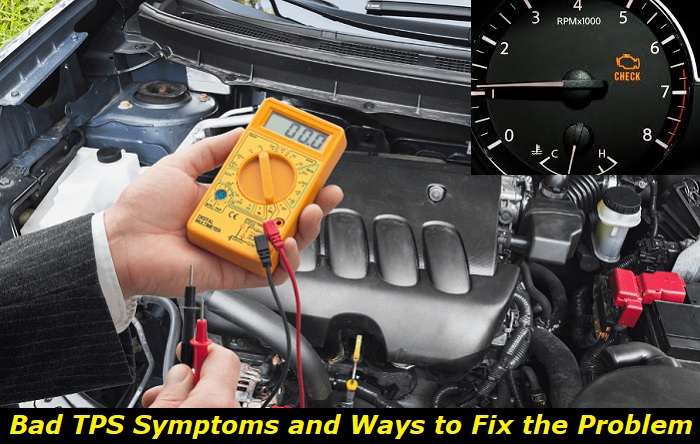When it comes to locating, diagnosing, and fixing a faulty TPS sensor, the process can be quite complex and time-consuming. Thankfully, there are some telltale symptoms that can help you determine if your TPS sensor is malfunctioning. In this article, we will explore common symptoms and how to diagnose and fix the problem.
Electrical equipment problems highlights
- Level of urgency:low
- DIY inspection:possible
- DIY repairs:possible but complicated
- Can you drive?yes
- Price of repairs:$150 - $350
- Ifignored:problems may develop and escalate
- Ways to fix:diagnose and replace the broken parts, try resetting the affected units

What is a TPS sensor, and how does it work?
A Throttle Position Sensor (TPS) is a type of sensor used to monitor the position of a vehicle's throttle. This information can be used by an engine control unit (ECU) to determine how much fuel should be injected into the cylinders and at what time, allowing for maximum power output while maintaining efficiency and clean emissions.
The TPS works by measuring the angle of the throttle plate in relation to the rest position. This signal is then sent to the ECU, which uses it to determine how much fuel should be injected into the cylinders for a given throttle position.
This allows the engine to respond quickly and accurately to changes in demand, providing smooth and efficient operation. In addition, the ECU can monitor the TPS for any malfunction or failure, allowing it to alert the driver and take action.
TPS sensors are an essential component in a modern fuel-injected vehicle, as they allow the ECU to adjust fueling quickly and accurately to match engine demand. Without them, cars would be prone to poor performance, emissions, and fuel economy. Overall, TPS sensors are a critical component in the operation of any modern vehicle.
Symptoms indicating problems with your TPS sensor
First and foremost, you should note any irregularities in your car's acceleration or idling. If your car is jerking, sputtering, or hesitating as you accelerate, then it could be a sign that there is something wrong with the TPS sensor. Additionally, if the engine idle is unusually high or low, then this could also be an indication of a problem with the TPS sensor.
Check Engine light is another symptom of possible TPS problems. The Check Engine light will usually come on when the ECU detects an issue with the TPS sensor or any other components of the vehicle's throttle system.
High consumption of fuel is another sign of a faulty TPS sensor. If your car's fuel economy has decreased significantly, then this could be an indication that the TPS sensor is not providing the proper information to the ECU. As a result, the engine may be running too rich or too lean, resulting in higher fuel consumption.
Another important symptom is automatic transmission shifting issues. If your car has trouble shifting smoothly or fails to shift at all, then a faulty TPS sensor could be the culprit. The ECU relies on throttle position data from the TPS in order to determine when and how to shift gears, so if it is not providing the correct information, then it can cause issues with transmission shifting.
In addition to these symptoms, you may also notice that the car has difficulty starting after being left for a period of time. This could indicate an issue with the TPS sensor as well. Finally, if you notice that your car's fuel economy has decreased, then it could be a sign of an issue with the TPS sensor.
Having your TPS sensor inspected will help ensure that your car is running properly and provide you with optimal performance. Additionally, failing to have a faulty TPS sensor fixed can lead to further damage to other parts of the engine.
In general, a TPS sensor can cause a variety of issues if it stops working correctly. If you are experiencing any of the symptoms mentioned above, then it is important to have your car inspected.
How to locate the TPS sensor?
The TPS sensor is typically located on the throttle body of your vehicle. To locate it, you'll need to remove the air intake tube and other components that are blocking access to the throttle body.
Once all the components have been removed, you should be able to see the TPS sensor mounted on the side of the throttle body. Make sure to take note of its orientation and how it is connected before you remove it.
Diagnosing a faulty TPS sensor
In order to diagnose a faulty TPS sensor, you'll need to use an OBD-II scanner or other diagnostic tool. This tool will allow you to check the voltage readings coming from the TPS sensor, as well as whether the sensor is responding correctly to changes in the throttle position. If any of these readings are out of range, then it could indicate a problem with the TPS sensor itself.
Fixing a faulty TPS sensor
Depending on the severity of the issue, it may be possible to fix a faulty TPS sensor without having to replace it. You may try to fix it or reprogram it, but if these methods do not work, then you'll need to replace the sensor.
1) Repairing TPS sensor
When repairing a TPS sensor, the first step is to check for any visible signs of damage. If there are no obvious signs of damage, then the sensor should be removed from the vehicle and cleaned.
This can be done by using a soft cloth to gently remove any dust or debris that may have accumulated on the sensor. Once the sensor is clean, it should be re-installed and checked for proper operation. If any issues remain, then the sensor should be replaced.
2) Reprogramming TPS sensor
In some cases, it may be possible to reprogram a TPS sensor rather than replace it. This is done by manually reprogramming the TPS sensor according to the manufacturer's instructions. This is usually done via a computer connected to the vehicle's diagnostic port. Once the TPS sensor has been reprogrammed, it should be tested to make sure that it is functioning correctly.
3) Replacing TPS sensor
If repairing and reprogramming doesn't help, then you may need to replace it with a new one. You can replace the sensor yourself or take your car to a qualified mechanic.
The process of removing and installing a new TPS sensor consists of the following steps:
- Disconnect the negative battery cable and leave it disconnected while you work on your vehicle.
- Locate the TPS sensor, which is usually located on the throttle body on top of the engine.
- Unscrew the mounting screws and slide off the sensor from its bracket.
- Disconnect the electrical connector from the TPS sensor by pressing on the tabs of the connector and gently pulling it away.
- Install a new TPS sensor in place of the old one and reconnect the electrical connector.
- Tighten the mounting screws and reattach the bracket.
- Reconnect the negative battery cable and start up your engine to test it out.
What is the cost of replacing the TPS sensor?
The cost of replacing the TPS sensor will depend on the vehicle's make and model, as well as the type of sensor required. It can range anywhere from $50 to over $200, plus labor. The cost of the parts and labor may also vary depending on where you take your car to be repaired.
Additionally, some older cars may require special parts that could add to the cost of repair. It's best to consult a trusted mechanic for an accurate quote.
Bottom Line
A faulty TPS sensor can cause your vehicle to experience decreased power and poor performance, so it's important to fix any issues with the sensor as soon as possible. Fixing or reprogramming a faulty TPS sensor is usually easier than replacing it, but if all else fails, then you may need to replace the sensor.
Make sure to take your vehicle to a qualified mechanic who has experience in replacing TPS sensors. This will ensure that the job is done properly and that you don't have any further problems with your vehicle.
About the authors
The CarAraC research team is composed of seasoned auto mechanics and automotive industry professionals, including individuals with advanced degrees and certifications in their field. Our team members boast prestigious credentials, reflecting their extensive knowledge and skills. These qualifications include: IMI: Institute of the Motor Industry, ASE-Certified Master Automobile Technicians; Coventry University, Graduate of MA in Automotive Journalism; Politecnico di Torino, Italy, MS Automotive Engineering; Ss. Cyril and Methodius University in Skopje, Mechanical University in Skopje; TOC Automotive College; DHA Suffa University, Department of Mechanical Engineering






Add comment